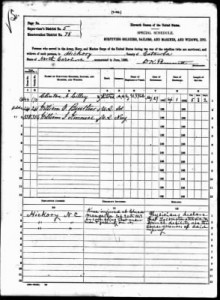
The Veterans’ Schedules, officially titled the Special Schedules of the Eleventh Census Enumerating Union Veterans and Widows of Union Veterans of the Civil War,” was a unique component of the United States Federal Census conducted that year. Unlike the general population census that aimed to count every resident, this special schedule was designed to record information about Union veterans of the Civil War and their surviving widows. The initiative was part of the broader Eleventh Census of the United States, which sought to document the population and various aspects of society following the Civil War.
The 1890 Veterans’ Schedules were crucial for several reasons. First, they documented the service and sacrifices of those who fought for the Union during the Civil War, offering insights into these individuals’ demographics and post-war experiences. Second, the schedules facilitated the administration of pensions and other veterans’ benefits, helping to ensure that those who had served or their surviving dependents received the support they were entitled to.
The schedules recorded detailed information about each veteran, including their name, rank, company, regiment or vessel, dates of enlistment and discharge, length of service, and any disabilities incurred during service. For widows, the schedules noted the deceased veteran’s name and the widow’s relationship to him.
It’s important to note that the 1890 Veterans’ Schedules only covered veterans from the Union side of the Civil War. Veterans who served in Confederate forces were not included in this enumeration. Additionally, the schedules predominantly covered selected states and territories, with the records for many states unfortunately lost or destroyed in a fire in 1921. Today, the surviving schedules are an invaluable resource for historians, genealogists, and researchers interested in the Civil War and its veterans. They provide a snapshot of the lives of those who served, offering a glimpse into their post-war circumstances and the legacy of the conflict within individual families and communities.
Listings Include:
- Individual’s first and last name.
- State, county, and residence locality at the time of the enumeration.
- National Archives Microfilm page number.
